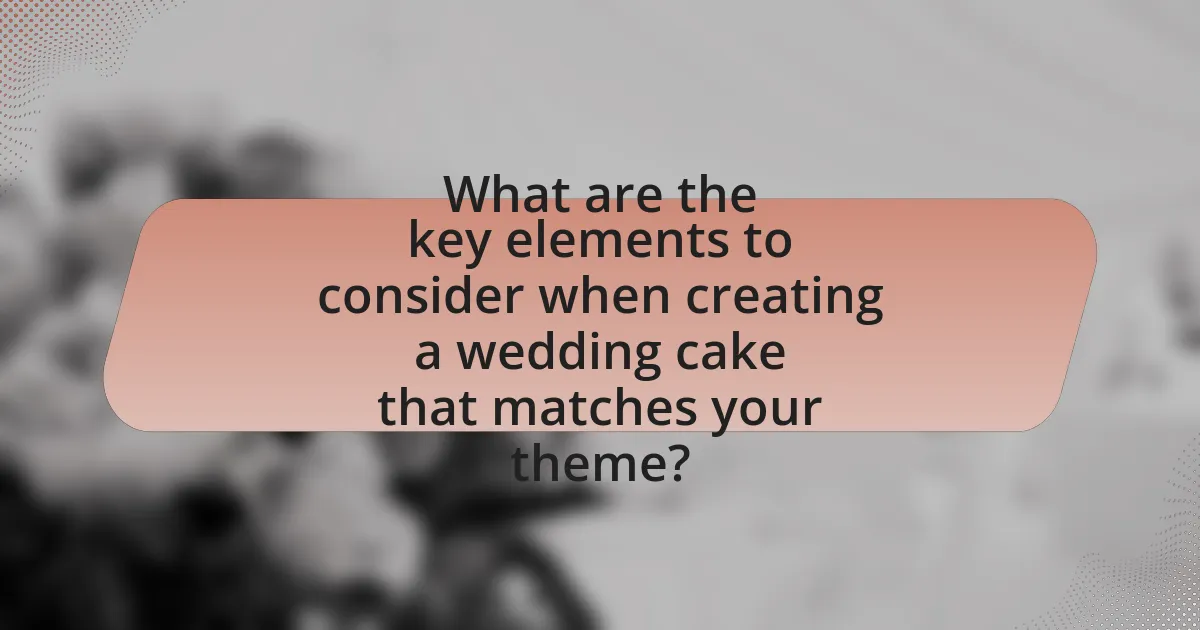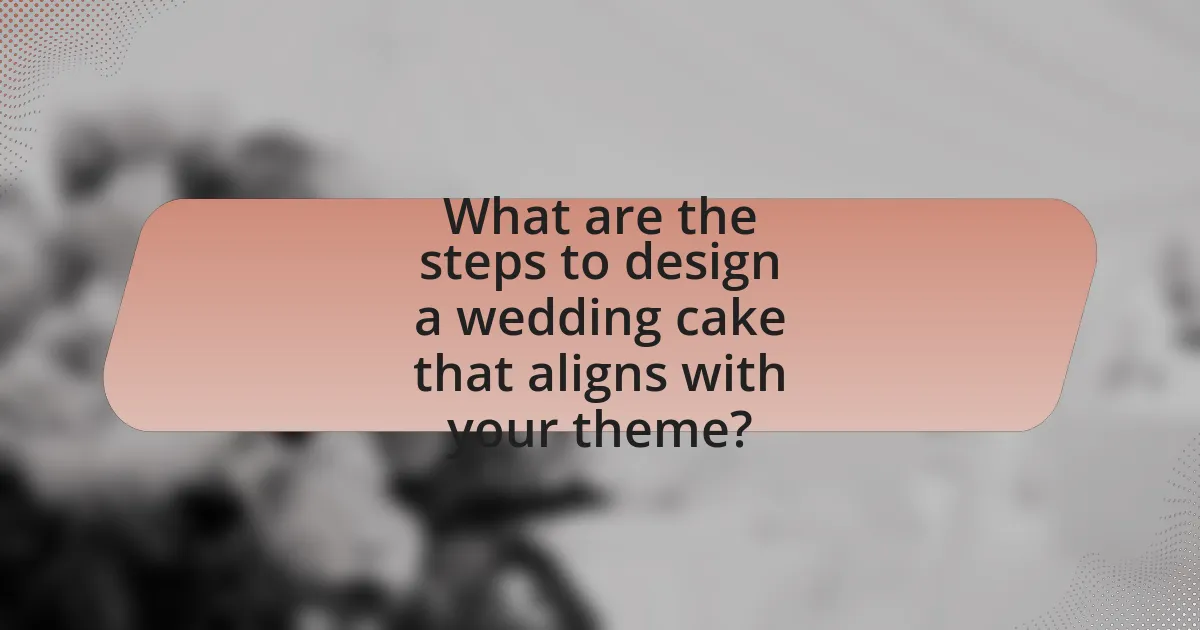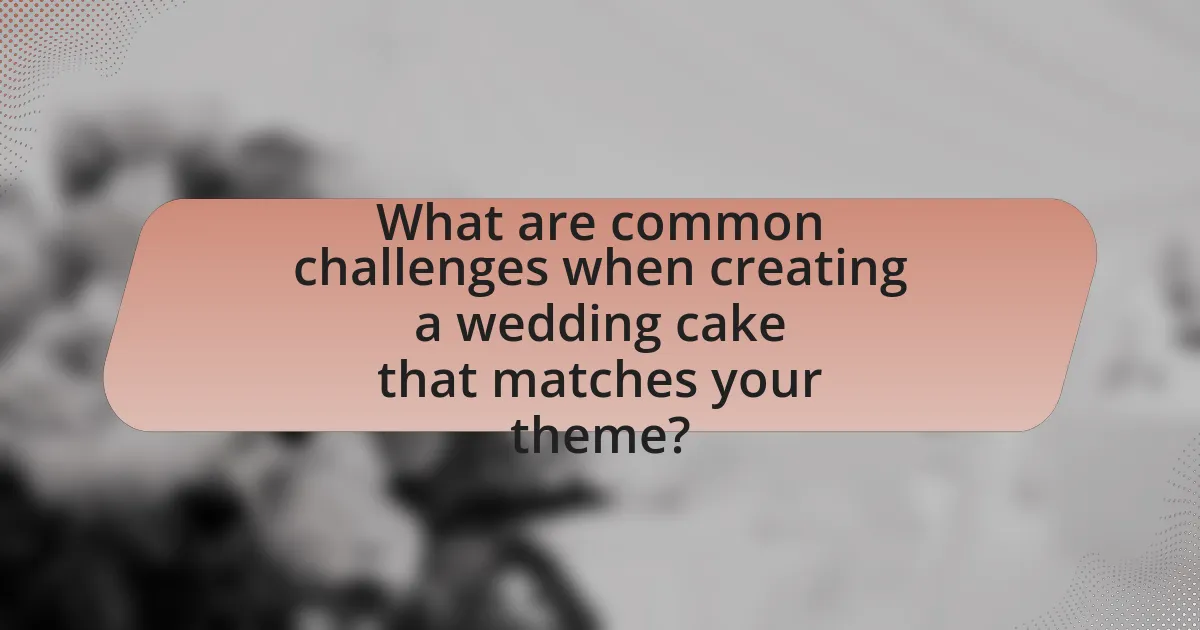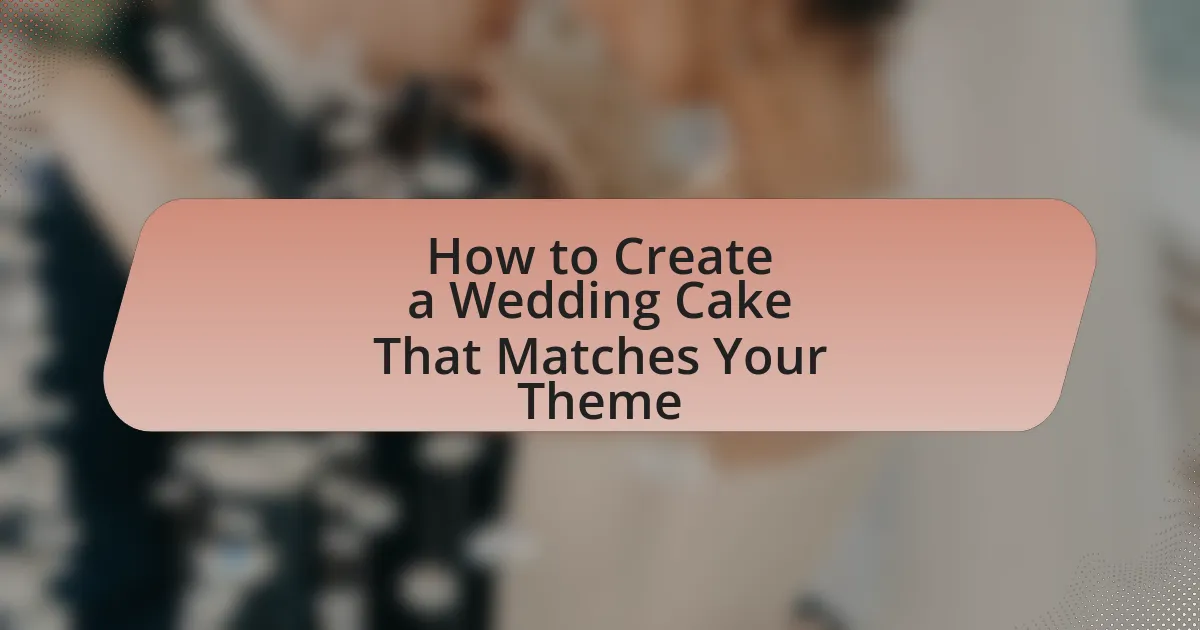The article focuses on creating a wedding cake that aligns with the overall wedding theme, emphasizing key elements such as flavor, design, color, and decoration. It explores how the wedding theme influences cake design, including the impact of color schemes and seasonal ingredients on decoration and flavor choices. The article also outlines various wedding themes, popular flavor combinations, and the importance of cake shape and structure in achieving theme alignment. Additionally, it provides practical steps for designing a themed wedding cake, addressing common challenges and best practices to ensure the final product meets expectations while staying within budget.

What are the key elements to consider when creating a wedding cake that matches your theme?
The key elements to consider when creating a wedding cake that matches your theme include flavor, design, color, and decoration. Flavor should align with the couple’s preferences and the overall wedding atmosphere, while design must reflect the wedding theme, whether it’s rustic, elegant, or modern. Color should complement the wedding palette, ensuring harmony with other decor elements. Decoration, such as flowers, toppers, and patterns, should enhance the cake’s visual appeal and cohesiveness with the theme. These elements collectively ensure that the wedding cake is not only delicious but also a fitting centerpiece that resonates with the overall wedding aesthetic.
How does the wedding theme influence cake design?
The wedding theme significantly influences cake design by dictating the colors, shapes, and decorative elements used. For instance, a rustic wedding theme may lead to a cake adorned with natural elements like flowers and wood textures, while a modern theme might favor sleek lines and geometric shapes. Additionally, the color palette of the wedding theme directly impacts the cake’s frosting and decoration choices, ensuring visual harmony with other wedding elements. This alignment is crucial, as studies show that cohesive design enhances the overall aesthetic experience of the event.
What are the different types of wedding themes?
Different types of wedding themes include traditional, rustic, vintage, modern, beach, garden, and destination themes. Each theme reflects specific styles and atmospheres, influencing the overall decor, attire, and even the wedding cake design. For instance, a rustic theme often features natural elements like wood and greenery, while a beach theme incorporates oceanic colors and motifs. These themes guide couples in selecting cohesive elements that enhance their wedding experience.
How can color schemes affect cake decoration?
Color schemes significantly influence cake decoration by establishing the visual appeal and thematic coherence of the cake. A well-chosen color palette can enhance the overall aesthetic, evoke emotions, and align with the wedding theme, making the cake a focal point of the celebration. For instance, a pastel color scheme may convey a soft, romantic atmosphere, while bold colors can create a vibrant and festive look. Research indicates that colors can affect perceptions; for example, blue is often associated with calmness, while red can evoke excitement. Therefore, selecting an appropriate color scheme is crucial for achieving the desired impact in cake decoration.
What role do flavors play in matching a wedding cake to the theme?
Flavors play a crucial role in matching a wedding cake to the theme by enhancing the overall sensory experience and aligning with the couple’s preferences and wedding aesthetics. For instance, a rustic-themed wedding may benefit from flavors like carrot or spice cake, which evoke a homey feel, while a modern, elegant theme might be complemented by sophisticated flavors such as chocolate ganache or lemon zest. The choice of flavors can reflect cultural traditions, seasonal ingredients, or personal stories, thereby reinforcing the wedding’s narrative. This alignment between flavor and theme not only satisfies guests’ palates but also creates a cohesive experience that resonates with the couple’s vision for their special day.
How can seasonal ingredients enhance the theme?
Seasonal ingredients can enhance the theme of a wedding cake by aligning the flavors and aesthetics with the time of year, creating a cohesive experience for guests. For example, using fresh berries in summer or spiced flavors like cinnamon and nutmeg in fall not only reflects the season but also evokes specific memories and emotions associated with that time. This approach is supported by culinary trends that emphasize local and seasonal sourcing, which can elevate the quality and taste of the cake while reinforcing the overall wedding theme.
What are popular flavor combinations for different themes?
Popular flavor combinations for different wedding cake themes include vanilla and almond for classic themes, chocolate and raspberry for romantic themes, lemon and blueberry for spring themes, and red velvet with cream cheese for vintage themes. These combinations are favored because they complement the aesthetics and emotions associated with each theme, enhancing the overall experience of the wedding. For instance, the vanilla and almond combination is often chosen for its timeless appeal, while chocolate and raspberry evoke a sense of romance, making them ideal for intimate celebrations.
How important is the cake’s shape and structure in theme alignment?
The cake’s shape and structure are crucial for theme alignment in wedding cakes. A well-defined shape, such as a tiered or sculpted design, directly reflects the wedding’s overall aesthetic and theme, enhancing visual coherence. For instance, a round cake may symbolize unity, while a square cake can convey modernity. Research indicates that visual elements significantly influence perception; thus, the cake’s structure can reinforce the intended theme, making it memorable for guests.
What are the most popular cake shapes for weddings?
The most popular cake shapes for weddings are round, square, and tiered. Round cakes are traditionally favored for their classic appearance and ease of serving, while square cakes offer a modern aesthetic and can be stacked for a dramatic effect. Tiered cakes, which can be round or square, allow for multiple flavors and designs, making them a versatile choice for couples. According to wedding industry surveys, round cakes account for approximately 60% of wedding cakes, highlighting their enduring popularity.
How can tiered cakes reflect the wedding theme?
Tiered cakes can reflect the wedding theme through their design, color scheme, and decorative elements. For instance, a rustic wedding theme may be complemented by a tiered cake adorned with natural elements like flowers, wood textures, or burlap accents. In contrast, a modern wedding theme might feature sleek lines, geometric shapes, and a minimalist color palette on the cake. Additionally, the flavors of the tiers can also align with the wedding theme; for example, a tropical theme could be represented with flavors like coconut and pineapple. This alignment between the cake’s aesthetics and the overall wedding theme enhances the visual coherence of the event, making the cake a focal point that resonates with the couple’s chosen style.

What are the steps to design a wedding cake that aligns with your theme?
To design a wedding cake that aligns with your theme, follow these steps: First, identify the wedding theme, including colors, style, and overall aesthetic. Next, choose cake flavors and fillings that complement the theme, ensuring they appeal to the couple and guests. Then, select a cake shape and size that fits the venue and guest count, while also reflecting the theme’s style, such as a classic tiered cake for a formal event or a rustic design for a casual celebration. After that, incorporate decorative elements like fondant, icing, and edible flowers that match the color palette and theme. Finally, collaborate with a professional baker who understands the vision and can execute the design accurately, ensuring the cake not only looks good but also tastes delicious.
How do you start the design process for a themed wedding cake?
To start the design process for a themed wedding cake, first, identify the wedding theme and color palette. This foundational step ensures that the cake aligns with the overall aesthetic of the event. Next, gather inspiration by researching cake designs that reflect the chosen theme, which can include elements like floral arrangements, patterns, and textures that resonate with the couple’s vision. Additionally, consider the flavors and types of cake that complement the theme, as this enhances the overall experience. By integrating these elements, the design process becomes a cohesive representation of the wedding’s theme.
What initial considerations should be made before designing?
Before designing a wedding cake, it is essential to consider the couple’s theme and color palette. Understanding the wedding theme ensures that the cake complements the overall aesthetic, whether it is rustic, elegant, or modern. Additionally, the color palette guides the selection of icing, decorations, and cake layers, creating visual harmony. Research indicates that 70% of couples prioritize theme coherence in their wedding planning, highlighting the importance of these initial considerations in achieving a cohesive celebration.
How can you gather inspiration for your cake design?
To gather inspiration for your cake design, explore various sources such as nature, art, and current design trends. Nature provides a rich palette of colors and textures, while art can inspire unique shapes and patterns. Additionally, researching popular wedding themes and color schemes can help align your cake design with the overall wedding aesthetic. For instance, a study by the American Institute of Graphic Arts highlights that visual elements from nature and art significantly influence design creativity. This evidence supports the idea that diverse sources can enhance cake design inspiration effectively.
What techniques can be used to incorporate theme elements into the cake?
Techniques to incorporate theme elements into a cake include using specific colors, shapes, and decorations that reflect the chosen theme. For instance, if the theme is floral, incorporating edible flowers or floral patterns in the icing can enhance the visual appeal. Additionally, using themed cake toppers or molds that represent elements of the theme, such as nautical designs for a beach wedding, can effectively tie the cake to the overall aesthetic. Furthermore, flavor choices can also align with the theme; for example, a tropical theme may feature coconut or pineapple flavors. These techniques ensure that the cake not only complements the wedding theme but also serves as a focal point that resonates with the overall design.
How can fondant and icing be used creatively for theme representation?
Fondant and icing can be used creatively for theme representation by allowing cake decorators to sculpt intricate designs and apply detailed textures that reflect specific themes. For instance, fondant can be molded into shapes like flowers, figurines, or themed objects, while icing can be piped to create patterns or images that align with the wedding’s color scheme and motif. This versatility enables decorators to customize cakes to match themes such as rustic, elegant, or whimsical, enhancing the overall aesthetic of the wedding. The ability to color fondant and icing in various shades further supports theme representation, as decorators can achieve precise hues that complement the wedding palette.
What are some examples of decorative elements that enhance the theme?
Examples of decorative elements that enhance the wedding cake theme include fondant decorations, edible flowers, and themed cake toppers. Fondant can be shaped into intricate designs that reflect the wedding’s color scheme or motif, while edible flowers add a natural and elegant touch that complements the overall aesthetic. Themed cake toppers, such as personalized figurines or symbols representing the couple’s interests, serve as focal points that tie the cake to the wedding’s theme. These elements not only beautify the cake but also reinforce the theme, making it cohesive with the overall wedding decor.
How do you finalize the design and ensure it meets expectations?
To finalize the design of a wedding cake and ensure it meets expectations, conduct a thorough review of the design elements against the couple’s preferences and the wedding theme. This involves confirming the cake’s size, flavor, and decoration details, ensuring they align with the overall aesthetic and requirements discussed during initial consultations. Additionally, creating a detailed mock-up or sketch can help visualize the final product, allowing for adjustments before production. Feedback from the couple at this stage is crucial, as it provides an opportunity to make necessary changes and confirm satisfaction with the design.
What should be included in a cake design consultation with a baker?
A cake design consultation with a baker should include discussions on the cake’s flavor, design elements, size, budget, and timeline. The baker will assess the client’s preferences for flavors, such as vanilla, chocolate, or red velvet, and explore design inspirations, including themes, colors, and styles that align with the wedding’s overall aesthetic. Additionally, the consultation should cover the number of servings required to ensure the cake meets guest needs, as well as the budget constraints to guide ingredient choices and design complexity. Finally, establishing a timeline for the cake’s creation and delivery is essential to ensure it aligns with the wedding schedule.
How can you create a mock-up or sketch of the cake design?
To create a mock-up or sketch of the cake design, begin by gathering inspiration from various sources such as wedding magazines, online platforms, or previous cake designs. This initial step helps in visualizing the desired style and elements. Next, use graph paper or digital design software to outline the cake’s tiers, shapes, and dimensions, ensuring accurate proportions. Incorporate details like colors, textures, and decorations in the sketch to represent the final look. This method allows for adjustments and refinements before actual baking, ensuring the design aligns with the wedding theme.

What are common challenges when creating a wedding cake that matches your theme?
Common challenges when creating a wedding cake that matches your theme include achieving the desired aesthetic, ensuring flavor compatibility, and managing structural integrity. The aesthetic challenge arises from the need to align the cake’s design with the overall wedding theme, which may involve specific colors, patterns, or motifs. Flavor compatibility is crucial, as the cake must not only look good but also taste appealing to guests, which can be difficult when trying to incorporate unique or themed flavors. Structural integrity is another challenge, as intricate designs may require additional support to prevent collapse, especially in multi-tiered cakes. These challenges necessitate careful planning and skilled execution to ensure the final product meets the couple’s vision and expectations.
What are the potential pitfalls in theme alignment for wedding cakes?
The potential pitfalls in theme alignment for wedding cakes include mismatched colors, inappropriate design elements, and failure to consider the overall wedding aesthetic. Mismatched colors can lead to a cake that stands out negatively rather than complementing the decor, as color theory suggests that harmonious color combinations enhance visual appeal. Inappropriate design elements, such as using a rustic style cake for a formal wedding, can create a disjointed look, undermining the intended theme. Additionally, failing to consider the overall wedding aesthetic may result in a cake that does not resonate with the couple’s vision or the venue’s ambiance, which can detract from the overall experience.
How can miscommunication with the baker affect the final product?
Miscommunication with the baker can lead to significant discrepancies in the final product, such as incorrect flavors, designs, or sizes. For instance, if a couple specifies a chocolate cake with raspberry filling but the baker misunderstands and prepares vanilla with strawberry filling, the cake will not meet the couple’s expectations. Additionally, unclear communication regarding dietary restrictions can result in a cake that is unsuitable for guests, potentially causing health issues. Accurate communication is essential to ensure that the cake aligns with the couple’s vision and requirements, as evidenced by numerous wedding planning guides emphasizing the importance of clear instructions and confirmations in the cake design process.
What are the risks of choosing overly complex designs?
Choosing overly complex designs for wedding cakes can lead to several risks, including increased costs, longer preparation times, and potential structural failures. Complex designs often require more intricate techniques and materials, which can significantly raise the overall expense of the cake. Additionally, the time needed for preparation and assembly can extend, leading to scheduling challenges and potential stress for bakers. Furthermore, overly intricate designs may compromise the cake’s structural integrity, increasing the likelihood of collapse or damage during transport or display. These factors highlight the importance of balancing aesthetic appeal with practicality in wedding cake design.
How can you troubleshoot issues that arise during the cake creation process?
To troubleshoot issues that arise during the cake creation process, first identify the specific problem, such as uneven baking, collapsing layers, or frosting issues. For uneven baking, ensure the oven temperature is accurate and rotate the cake pans halfway through baking. If layers collapse, check that the batter is not overmixed and that the correct amount of leavening agents is used. For frosting issues, ensure the butter is at the right temperature and that the frosting is mixed adequately to achieve the desired consistency. These troubleshooting steps are based on common baking practices and can significantly improve the outcome of the cake.
What steps can be taken if the cake does not match the theme as planned?
If the cake does not match the theme as planned, the first step is to communicate with the baker to discuss the discrepancies. This allows for an understanding of what went wrong and whether adjustments can be made. Next, consider adding decorative elements that align with the theme, such as themed cake toppers or edible decorations, which can enhance the overall appearance. Additionally, if time permits, a complete redesign of the cake may be necessary, involving a new consultation with the baker to ensure alignment with the desired theme. These steps are effective because they address the issue directly and provide solutions that can be implemented quickly, ensuring the cake complements the wedding theme.
How can you ensure the cake remains fresh and visually appealing on the wedding day?
To ensure the cake remains fresh and visually appealing on the wedding day, store it in a cool, dry place and cover it with a cake box or plastic wrap to protect it from air exposure. Keeping the cake at a stable temperature prevents it from drying out or melting, which is crucial for maintaining both texture and appearance. Additionally, using high-quality ingredients and proper frosting techniques can enhance the cake’s visual appeal and freshness. For instance, cakes made with fresh ingredients typically have a better taste and texture, while fondant can provide a smooth, polished look that holds up well over time.
What are some best practices for creating a wedding cake that matches your theme?
To create a wedding cake that matches your theme, start by selecting colors, designs, and flavors that align with the overall wedding aesthetic. For instance, if the wedding theme is rustic, consider using natural elements like wood textures and floral decorations, while a modern theme may benefit from sleek lines and geometric shapes. Additionally, incorporating elements such as edible flowers or themed cake toppers can enhance the connection to the theme. Research indicates that 70% of couples prioritize the cake’s design to reflect their wedding theme, emphasizing the importance of cohesive visual elements.
How can you effectively communicate your vision to your baker?
To effectively communicate your vision to your baker, provide clear and detailed descriptions of your desired cake design, flavors, and overall theme. Use visual aids such as inspiration photos, sketches, or mood boards to illustrate your ideas, ensuring the baker understands your aesthetic preferences. Additionally, discussing specific elements like color schemes, textures, and any symbolic details will help convey your vision accurately. Research shows that visual communication enhances understanding, making it easier for bakers to align their creations with clients’ expectations.
What tips can help you stay within budget while achieving your desired theme?
To stay within budget while achieving your desired wedding cake theme, prioritize planning and research. Begin by setting a clear budget limit for the cake, which allows you to focus on options that fit within that financial framework. Next, explore local bakeries and compare prices, as costs can vary significantly; for instance, a custom cake can range from $3 to $10 per slice depending on design complexity and ingredients. Additionally, consider simpler designs that still reflect your theme, as intricate decorations often increase costs. Using seasonal ingredients can also reduce expenses while enhancing flavor. Lastly, limit the size of the cake to what is necessary for your guest count, as larger cakes incur higher costs. These strategies collectively ensure that you can achieve your desired theme without overspending.
